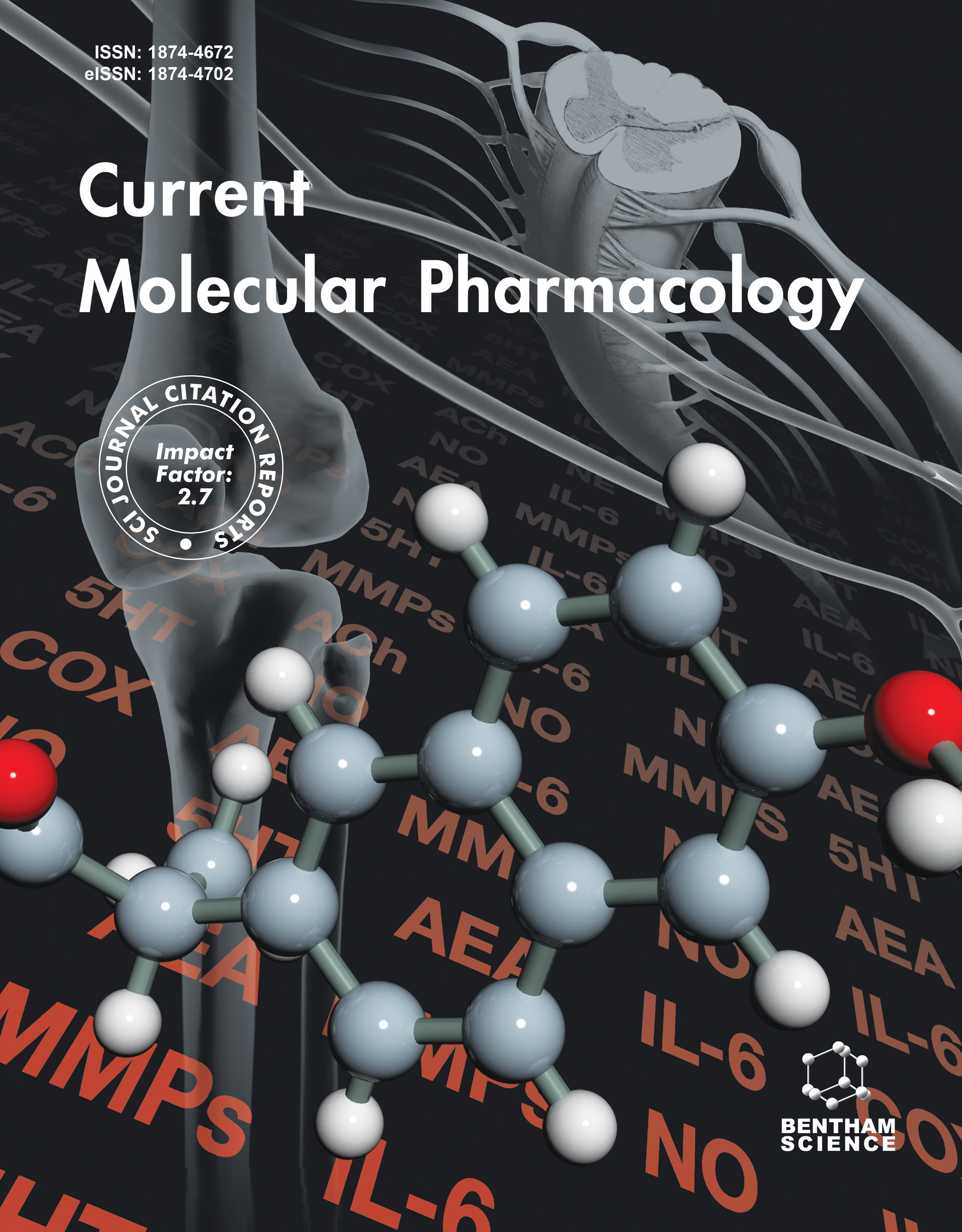- Home
- A-Z Publications
- Current Molecular Pharmacology
- Previous Issues
- Volume 16, Issue 1, 2023
Current Molecular Pharmacology - Volume 16, Issue 1, 2023
Volume 16, Issue 1, 2023
-
-
Immunomodulatory Therapeutic Effects of Curcumin on M1/M2 Macrophage Polarization in Inflammatory Diseases
More LessBackground: Due to their plasticity, macrophages exert critical effects on both promoting and suppressing inflammatory processes. Pathologic inflammatory conditions are frequently correlated with dynamic alterations in macrophage activation, with classically activated M1 cells associated with the promotion and maintenance of inflammation and M2 cells being linked to the resolution or smouldering of chronic inflammation Read More
-
-
-
Antifungal Activity of Plant Secondary Metabolites on Candida albicans: An Updated Review
More LessFungal infections have been increasing continuously worldwide, especially in immunocompromised individuals. Fungi, regarded as eukaryotic pathogens, have many similarities to the host cells, which inhibit anti-fungal drug development progress. Various fungal model systems have been studied, and it was concluded that Candida spp. is the most common disease-causing fungus. Candida species are well known to cause i Read More
-
-
-
Gut Microbiota Modulation for Therapeutic Management of Various Diseases: A New Perspective Using Stem Cell Therapy
More LessAuthors: Lamiaa A. Ahmed and Khaled F. Al-MassriDysbiosis has been linked to various diseases ranging from cardiovascular, neurologic, gastrointestinal, respiratory, and metabolic illnesses to cancer. Restoring of gut microbiota balance represents an outstanding clinical target for the management of various multidrug-resistant diseases. Preservation of gut microbial diversity and composition could also improve stem cell therapy which now has diverse clinical applications Read More
-
-
-
Clozapine-induced Myocarditis: Pathophysiologic Mechanisms and Implications for Therapeutic Approaches
More LessAuthors: Simon W. Rabkin and Jacky K. K. TangClozapine, a superior treatment for treatment-resistant schizophrenia can cause potentially life-threatening myocarditis and dilated cardiomyopathy. While the occurrence of this condition is well known, its molecular mechanisms are unclear and may be multifactorial. Putative mechanisms warrant an in-depth review not only from the perspective of toxicity but also for understanding the molecular mechanisms Read More
-
-
-
Targeting Signaling Pathway by Curcumin in Osteosarcoma
More LessAuthors: Parnia R. Farnood, Romina Danesh Pazhooh, Zatollah Asemi and Bahman YousefiThe most prevalent primary bone malignancy among children and adolescents is osteosarcoma. The high mortality rate of osteosarcoma is due to lung metastasis. Despite the development of multi-agent chemotherapy and surgical resection, patients with osteosarcoma have a high metastasis rate and poor prognosis. Thus, it is necessary to identify novel therapeutic agents to improve the 5-year survival rate of these patients. Read More
-
-
-
Toxicity, Genotoxicity, and Carcinogenicity of Isotretinoin
More LessBackground: Acne is a chronic inflammatory disease mainly observed in adolescence, but it can also be seen during the neonatal, infantile, pre-pubertal, and adult periods. Isotretinoin (13-cis-retinoic acid) is a first-generation retinoid and is the most effective treatment for acne vulgaris. Objective: The present study has been systematically designed to figure out the toxic, genotoxic, and carcinogenic activities of isotretino Read More
-
-
-
Hesperidin Exerts Anxiolytic-like Effects in Rats with Streptozotocin- Induced Diabetes via PKA/CREB Signaling
More LessAuthors: Xia Zhu, Haiyan Liu, Zongli Deng, Chuanzhi Yan, Yaowu Liu and Xiaoxing YinBackground: The mechanisms underlying synaptic injury and anxiety-like behavioral changes caused by diabetes and the strategies to reverse these changes are not well understood. Objectives: This study examined the neuroprotective effects of hesperidin on anxiety-like behaviors in diabetic rats and investigated the underlying mechanisms from the perspective of the PKA/CREB pathway. Methods: Rats with streptozot Read More
-
-
-
The Effects of Acute and Chronic Sleep Deprivation on the Immune Profile in the Rat
More LessAuthors: Alaa Fahmawi, Mohammad S. Khalifeh, Karem H. Alzoubi and Abeer M. Rababa’hBackground: Acute and chronic sleep deprivation present many health-related problems in modern societies, mainly concerning the immune system. Immune factors, particularly the interleukins, regulate sleep and, therefore, may be altered by sleep deprivation (SD). Objectives: We aimed to investigate the possible effects of acute and chronic sleep deprivation on selected cytokines, including interleukins (IL-1β, IL-9, Read More
-
-
-
Ethoxidol as a Broad-spectrum Adaptogen
More LessBackground: Stress factors lead to a shift in the antioxidant-prooxidant relationship, allowing an increase in the generation of reactive oxygen species (ROS) by mitochondria, which results in the development of oxidative stress. Consequently, it is possible to put forward an assumption that drugs which reduce the excessive generation of ROS by these organelles should increase the body's resistance to stress factors. Antioxi Read More
-
-
-
MiR-129-2-3p Inhibits Esophageal Carcinoma Cell Proliferation, Migration, and Invasion via Targeting DNMT3B
More LessAuthors: Xuyang Peng, Xuhui Wu, Gongzhi Wu, Chongxiong Peng, Bin Huang, Mingjiang Huang, Jianyang Ding, Chaofan Mao and Huaizhong ZhangPurpose: The study aims to explore the regulatory mechanism of miR-129-2-3p underlying esophageal carcinoma (EC) cell progression and generate new ideas for targeted treatment of EC. Methods: Mature miRNA expression data and total RNA sequencing data of EC in the TCGAESCA dataset were utilized to explore differentially expressed miRNAs (DEmiRNAs). StarBase database was then utilized to predict targets of Read More
-
-
-
Nicorandil and Bone Marrow-derived Mesenchymal Stem Cells Therapeutic Effect after Ureteral Obstruction in Adult Male Albino Rats
More LessAuthors: Heba M. Abdel-Aziz, Nahla E. Ibrahem, Noura H. Mekawy, Amal Fawzy, Noura M. Mohamad and Walaa SamyBackground: Chronic kidney disease is a global health problem for which renal fibrogenesis is the final treatment target. Objective: In our work, we have highlighted two new strategies, nicorandil and Bone marrow-derived mesenchymal stem cells (BM-MSCs), as effective in reversing renal fibrosis induced by partial unilateral ureteral obstruction (PUUO). Methods: The current study included 96 male albino rats randomly divi Read More
-
Most Read This Month
Article
content/journals/cmp
Journal
10
5
false
en


